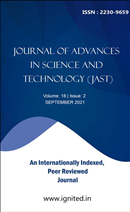A Study the Efficiency of Developed Solar Cell Includes Perovskite Cell
Keywords:
Solar Cells, Perovskite, Photovoltaics, Hybrid Perovskite Solar Cells (PSCs)Abstract
Solar energy is the energy obtained by capturing heat and light from the Sun. The sun light required for photovoltaics is however not continuous and has daily and seasonal variations. To get continuous electricity supply there is a need for batteries to back up the energy when there is peak solar irradiation during the day time. The conventional lead acid and lithium-ion batteries are used for energy storage. Photovoltaics convert the light energy from the sun into directly usable electrical energy. The solar cells are the fastest growing alternative energy system in the past decade. There are a few critical technical and implementation issues preventing it from mass utilization. The increasing demand for renewable energy sources has driven extensive research into advanced solar technologies, with perovskite solar cells emerging as a promising candidate due to their high efficiency and low production costs. This study investigates the efficiency of a newly developed solar cell that incorporates perovskite materials. The perovskite materials which are solution-processed have accomplished amazing milestone in only a couple of years.
Downloads
References
Alice E. Williams et al., “Perovskite processing for photovoltaics: a spectro-thermal evaluation,” Journal of Materials Chemistry A, vol. 120, no. 38, pp. 19338–19346, 2014.
Bakr, Z. H., Wali, Q., Fakharuddin, A., Schmidt-Mende, L., Brown, T. M., & Jose, R. (2017). Advances in hole transport materials engineering for stable and efficient perovskite solar cells. Nano Energy, 34(November 2016), 271–305. https://doi.org/10.1016/j.nanoen.2017.02.025
Dixit, H., Punetha, D., & Pandey, S. K. (2019). Improvement in performance of lead free inverted perovskite solar cell by optimization of solar parameters. Optik, 179, 969-976.
Holzhey, P., & Saliba, M. (2018). A full overview of international standards assessing the longterm stability of perovskite solar cells. Journal of Materials Chemistry A, 6(44), 21794– 21808. https://doi.org/10.1039/C8TA06950F
Huang, L., Sun, X., Li, C., Xu, R., Xu, J., Du, Y., ... & Zhang, J. (2016). Electron transport layer-free planar perovskite solar cells: further performance enhancement perspective from device simulation. Solar Energy Materials and Solar Cells, 157, 1038-1047.
International Electrotechnical Commission (IEC). (2016). IEC 61215-2:2016 Terrestrial photovoltaic (PV) modules - Design qualification and type approval - Part 2: Test procedures. Retrieved August 1, 2019, from https://webstore.iec.ch/publication/24311
K. Maram, M. Haghighi, O. Shekoofa, H. Habibiyan, and H. Ghafoorifard, “A modeling study on utilizing ultra-thin inorganic HTLs in inverted p–n homojunction perovskite solar cells,” Sol. Energy, vol. 213, no. November 2020, pp. 1–12, 2021, doi: 10.1016/j.solener.2020.11.009.
Moreira, M., et al., Structural and Optical Properties of CaTiO3 Perovskite-Based Materials Obtained by Microwave-Assisted Hydrothermal Synthesis: An Experimental and Theoretical Insight. Acta Materialia, 2009. 57.
N. A. K. and J. O. Muhammad Imran, Hikmet Coskun, Furkan H. Isikgor, Li Bichen, “Highly efficient and stable inverted perovskite solar cell with 2D ZnSe depositing using a thermal evaporator for electon collection.” p. 22713, 2018.
P. Umari, E. Mosconi and F. De Angelis, “Relativistic GW calculations on CH3NH3PbI3 and CH3NH3SnI3 Perovskites for Solar Cell Applications,” Scientific reports, vol. 4, no. 4467, pp. 1–7, 2014.
Shao, S., Liu, J., Portale, G., Fang, H. H., Blake, G. R., ten Brink, G. H., … Loi, M. A. (2018). Highly Reproducible Sn-Based Hybrid Perovskite Solar Cells with 9% Efficiency. Advanced Energy Materials, 8(4). https://doi.org/10.1002/aenm.201702019
T. H. Chowdhury et al., “Prospects of Ternary Cd1−xZnxS as an Electron Transport Layer and Associated Interface Defects in a Planar Lead Halide Perovskite Solar Cell via Numerical Simulation,” Journal of Electronic Materials, vol. 47, no. 5, pp. 3051– 3058, 2018
Yaghoobi Nia, N., Zendehdel, M., Cinà, L., Matteocci, F., & Di Carlo, A. (2018). A crystal engineering approach for scalable perovskite solar cells and module fabrication: A full out of glove box procedure. Journal of Materials Chemistry A, 6(2), 659–671. https://doi.org/10.1039/c7ta08038g
Zuo, F., Liang, P.-W., Liao, C.-Y., Williams, S. T., Chueh, C.-C., & Jen, A. K.-Y. (2014). Role of Chloride in the Morphological Evolution of Organo-Lead Halide Perovskite Thin Films. ACS Nan o, 8(10), 10640–10654. https://doi.org/10.1021/nn5041922






